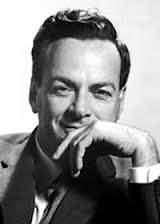Richard P. Feynman
Born May 11, 1918, Far Rockaway, N. Y; died February 15, 1988, Los Angeles, Calif.; Nobel Laureate, who, in the late 1940s, first identified computer addiction as a disease.

Education: BS, theoretical physics, MIT, 1939; PhD, theoretical physics, Princeton University, 1942.
Professional Experience: physicist, Princeton University, 1941-1942; physicist, Los Alamos Project (Manhattan Project), 1941-1945; associate professor, physics, Cornell University, 1945-1951; Tolman Professor of Physics, California Institute of Technology, 1951-1988.
Honors and Awards: Nobel Prize in Physics, 1965; Einstein Award, 1954.
Feynman, one of the most influential scientific thinkers and calculators of the post-World War II era, co-winner of the Nobel Prize for his reconstruction of quantum mechanics and electrodynamics, bestselling author, and whistle-blowing commissioner-investigator of the Challenger space-shuttle disaster, died February 15, 1988, at the age of 69, of abdominal cancer. He is survived by a generation of students who learned quantum physics from the three volumes of his lectures published in 1963 and called by The Economist "one of the best physics texts, as well as the most readable."
Feynman was born in 1918 in Far Rockaway, N.Y., and graduated with a BS from MIT in 1935. At Princeton, where he received his PhD in 1942, he started working on the Manhattan Project. This kept him at Los Alamos from 1943 to 1946, where he was put in charge of the group using IBM punched card machines for implosion calculations. There he identified the now well-known computer disease, describing it in these terms: "It's a very serious disease and it interferes completely with the work. The trouble with computers is you play with them. They are so wonderful. You have these switches--if it's an even number you do this, if it's an odd number you do that--and pretty soon you can do more and more elaborate things if you are clever enough, on one machine.... If you've ever worked with computers you understand the disease-the delight in being able to see how much you can do."
After Los Alamos, Feynman never contracted that disease and he never worked with the military again.
Hans Bethe took him to Cornell where he did the work that led to his Nobel Prize, reconstructing and restating quantum mechanics and electrodynamics in terms of particles. This work resulted in his famous diagrams of their interaction trajectories and his simplified rules of calculation, which became standard tools of theoretical analysis.
In 1951 he went to Cal Tech where he remained until his death.
His autobiography, described by him as a collection of stories, was published in 1985 as told to Ralph Leighton with the title, "Surely You're joking, Mr Feynman!" Adventures of a Curious Character Reissued in soft cover, it has been for several years one of the top sellers in college bookstores. The stories describe an outrageous, provocative, mischievous, compulsive smart-aleck puzzle solver who is indignantly impatient with the pretension and hypocrisy encountered in academia, government, and real life, and with a talent and determination to put down and one-up those who would do the same to him.
Although the stories tell much about Feynman the warm human, they say little about the central focus of his life, his attitude toward the science of physics. In the autobiography's introduction, Albert R. Hibbs tells how Feynman's feelings about physics came across to his Cal Tech students:
I remember when I was his student how it was when you walked into one of his lectures. He would be standing in front of the hall smiling at us all as we came in, his fingers tapping out a complicated rhythm on the black top of the demonstration bench that crossed the front of the lecture hall. As latecomers took their seats, he picked up chalk and began spinning it rapidly through his fingers in a manner of a professional gambler playing with a poker chip, still smiling happily as if at some secret joke. And then-still smiling-he talked to us about physics, his diagrams and equations helping us to share his understanding. It was no secret joke that brought the smile and the sparkle in his eye, it was physics. The joy of physics. The joy was contagious. We are fortunate who caught that infection....
His fame in the scientific and academic worlds as a teacher, theoretician, and author broadened to all the world when in 1986 he was appointed to the President's Commission on the Space Shuttle Challenger Accident. When the appointment was announced an old friend asked the pertinent question, "Do they realize that Feynman asks questions-and that he keeps asking them until he gets answers?" Feynman believed that NASA and its contractors were overrun by zealotry, self-delusion and complacency, said so, and called out specific details in his independently issued report, "Personal Observations on the Reliability of the Shuttle." His demonstration that the shuttle's O-ring material hardened when cold, which he made by dipping a piece in his glass of ice water while listening to testimony with the commission in front of the TV cameras, was typical of his iconoclastic, elegant, but simple approach to the realities of technology. [From Weiss 1988.]
QUOTATION
"[There is a] computer disease that anybody who works with computers knows about. It's a very serious disease and it interferes completely with the work. The trouble with computers is that you play with them! (Reminiscences of Los Alamos, 1943-1945)
BIBLIOGRAPHY
Biographical
Feynman, Richard P., Surely You're Joking, Mr Feynman: Adventures of a Curious Character, W.W. Norton & Co., New York, 1985.
Feynman, Richard P., "Los Alamos from Below," Ann. Hist. Comp., Vol. 10, No. 4, 1989, pp. 343-345.
Weiss, E. A., "Richard P. Feynman: Obituary," Ann. Hist. Comp., Vol. 10, No. 2, 1988, pp. 141-142.
UPDATES
Portrait added (MRW, 2012)
New content Copyright © 2013-2023 by the IEEE Computer Society and the Institute of Electrical and Electronics Engineers Inc.
All rights reserved. This material may not be reproduced or redistributed without the express written permission of the copyright holder.
